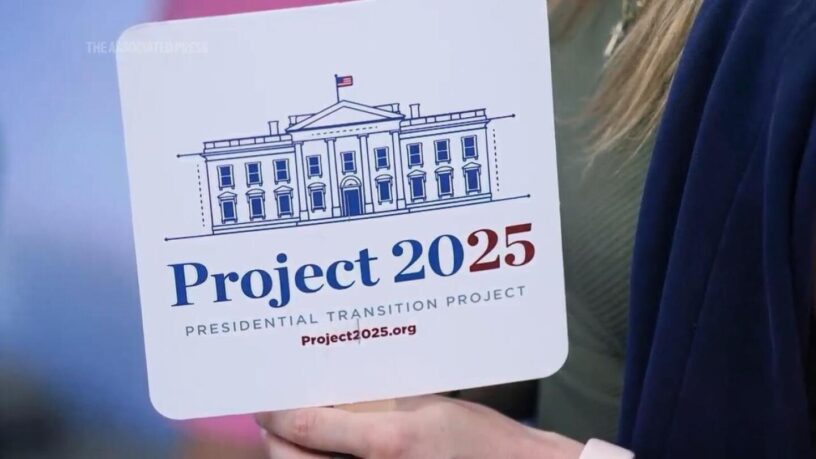NOTE: This article appeared in the August 12, 2024 issue of Community College Daily and the August 19, 2024 issue of CommonWealth Beacon.
“We all have a blind spot and it’s shaped exactly like us.”
Junot diaz
Higher education leaders across America have been white-knuckle doomscrolling on their cell phones in recent weeks, aghast at headlines warning about what a conservative takeover of the White House and Congress in November might mean for the nation’s colleges and universities.
They are right to be anxious.
After all, in a speech he delivered to the National Conservatism Conference in 2021 called “The Universities are the Enemy,” Donald Trump’s Vice Presidential running mate J.D. Vance complained, “We have got to get out of the mindset that the only way to live a good life in this country, the only way for our children to succeed is to go to a four-year university where people will learn to hate their country and acquire a lot of debt in the process.”
Instead, he challenged, “If any of us want to do the things that we want to do for our country and for the people who live in it, we have to honestly and aggressively attack the universities.”
As unhinged and beyond-the-fringe as that may sound to campus leaders, he is far from alone in his opinion.
Between the rising cost of college and soaring student loan debts, skepticism about the value of a degree, rampant “wokeness,” free speech suppression, and campus protests over the war in Gaza, the reputation of America’s colleges and universities has fallen off a cliff.
A recent survey from Gallup and the Lumina Foundation reveals that nearly a third of Americans have “very little or no confidence in higher education,” an increase of more than twenty percent since the poll was first taken in 2015.
In addition to Vance’s broadsides, college leaders have also been fretting about the Heritage Foundation’s Mandate for Leadership: The Conservative Promise (aka “Project 2025”) and how it might “radically overhaul higher ed.”
Weighing in at a hefty 922 pages, “Project 2025” includes a chapter written by Lindsey Burke, the Foundation’s Director of Education Policy, with a laundry list of recommendations:
- Federal education policy should be limited.
- Regulations and oversight should be reduced or, in some cases, eliminated.
- States should be the primary education policy makers.
- Families and students should be free to choose from among a wide array of educational options that fit their needs (including faith-based institutions).
- Charter schools should be encouraged and supported.
- Education should prepare students for jobs in the workforce.
- Career and technical education should be on an even playing field with college degrees.
Nothing too surprising there.
But tossed into this mix of pretty standard issue conservative thinking points about how American education should operate is a healthy dose of grievances, conspiracy theories (like the Chinese Communist Party plot to take over America through its universities), and a particular obsession with sex and the Left’s “radical gender ideology” that seems to border on the obsessive.
At its most extreme, “Project 2025” insists that schools, teachers, and curricula must be “pro-American” (even as it criticizes universities for not valuing academic freedom and intellectual diversity); recommends dropping all Title IX investigations that are based on gender orientation; banning teachers from calling students by any name other than the one on their birth certificate, or using pronouns other than the one assigned to them based on their biological sex at birth; eliminating federal funding for Hispanic Serving Institutions and Asian American and Pacific Islander Serving Institutions; and significantly reducing the oversight authority of accrediting agencies that monitor quality standards for K-12 schools and universities.
Oh yeah, and completely eliminating the United States Department of Education.
It’s fairly easy for higher ed leaders to take offense with the rancorous tone of Vance’s speeches and some of the wilder accusations and recommendations in “Project 2025,” and to quibble with their intellectual honesty.
But if we are honest with ourselves, we will also recognize that they aren’t entirely wrong.
If instead of immediately denying, rationalizing, or explaining their criticism away, we instead sift through it for kernels of truth and points of agreement, what might we learn and possibly improve about the enterprise of higher education in America today?
And in the process, might we regain some of the trust and support that has been lost in recent years?
Here are a few places we may be able to find some common ground:
Are Four-Year College Degrees Necessary?
Although Vance himself is a Yale alum and Burke attended three universities on her way to a PhD in education policy, both insist that college degrees aren’t necessary. In “Project 2025,” Burke recommends that the Department of Education should instead “be rebalanced to focus far more on bolstering the workforce skills of Americans who have no interest in pursuing a four-year academic degree.”
Further, the report recommends that, “The President should issue an executive order stating that a college degree shall not be required for any federal job unless the requirements of the job specifically demand it.”
On these points, many liberals and conservatives already seem to agree, suggesting perhaps we could lean in even further.
When Massachusetts Governor Maura Healey announced the “Lead by Example Employer Talent Initiative” earlier this year, she joined other liberal states like California, as well as conservative states like Arizona and Louisiana, in recognizing that “credential inflation” had gone too far, and it was time to abandon bachelor’s degrees as requirements for most state jobs.
And colleges, for their part, have recognized the need for change and have been getting creative with credentialing.
Southern New Hampshire University has famously grown from a small, sleepy regional campus of 3,000 students to an international, online juggernaut with enrollment topping 140,000, largely through its approach to “Competency Based Education” that offers the opportunity to complete degrees more quickly by demonstrating skills and knowledge, rather than logging hours in a classroom.
And after years of advocating for shortened degree timelines, College-in-3 gained some ground this year when the New England Commission of Higher Education (NECHE) released guidelines for universities, like Merrimack College here in Massachusetts, that want to offer baccalaureate degrees with fewer than 120 credits (typically four years of classes).
Meanwhile, associate degree institutions like Northern Essex Community College offer a range of Credit for Prior Learning options, articulation of non-credit workforce classes into for-credit degrees, and have been expanding the number of certificates and degrees available through Competency Based Education.
Are We Measuring Educational Quality Correctly?
The U.S. Department of Education uses the Integrated Postsecondary Education Data System (IPEDS) and the College Scorecard to measure and report a wide range of data about the performance of colleges and universities, from admissions, enrollment and student characteristics, to retention, costs, and how institutions spend their money.
“Project 2025” rightly notes that two points of data in particular, graduation rates and average earnings, are often used to demonstrate educational quality: Universities that graduate more students into lucrative careers are assumed to be better than those with higher dropout rates and graduates in low-paying jobs who struggle to repay student loan debt.
Except, as most higher education leaders (especially those of us at community colleges) know, zip codes are often destiny, and graduation rates and average earnings depend a lot on socioeconomic background and family status.
So, as “Project 2025” points out so perfectly:
Colleges and universities with selective admissions policies post the strongest outcomes, primarily because they admit mostly low-risk, traditional students. Open enrollment institutions post the weakest outcomes, largely because life is challenging and complicated for low-income and non-traditional students, who may be forced to drop out when a work schedule changes, a child needs more attention, or an unexpected repair or medical bill makes continuing impossible.
The conservatives’ proposed solution is one that higher education leaders should immediately embrace: Just as the Department of Health and Human Services considers risk-adjusted metrics to evaluate hospitals that serve socioeconomically disadvantaged patient populations, “Higher education outcomes data should be similarly ‘risk adjusted’ to more carefully isolate the impact of educational quality versus socioeconomic status and other factors on college outcomes.”
If we did this, then in addition to IPEDS and the College Scorecard, we might find ourselves using something like the “Mobility Report Cards” provided by Opportunity Insights that “score” colleges on a combination of access and success of their low-income students, and the proportion of those students who come from families in the bottom 20% of income distribution, and reach the top 20%.
Spoiler alert: Since open access community colleges and state universities admit far more low-income students, they tend to be much better at launching more of them up the socioeconomic ladder than Ivy league institutions.
If public policy and public funding then followed these metrics, we might find ourselves actually strengtheningboth the performance and the reputation of under-resourced institutions that serve the greatest numbers of our nation’s low-income and minority students.
Have Diversity, Equity, and Inclusion Efforts Gone Too Far?
Some of conservatives’ harshest criticisms of higher education are reserved for how colleges and universities, in their estimation, have allowed DEI (Diversity, Equity, and Inclusion) initiatives and “critical race theory” to take over every aspect of the student experience.
Vance rages, “Why are schoolchildren learning from schoolteachers that America is a fundamentally racist and evil country? Because those same schoolteachers learned it from some progressive professor at a university ten or fifteen years ago.”
And “Project 2025” inveighs, “When critical race theory is used as part of school activities such as mandatory affinity groups, teacher training programs in which educators are required to confess their privilege, or school assignments in which students must defend the false idea that America is systemically racist, the theory is actively disrupting the values that hold communities together such as equality under the law and colorblindness.”
It’s worth remembering that it wasn’t that long ago that these were the values most prized by progressives.
The mid-20th century American Civil Rights Movement proclaimed, in the words of Martin Luther King, Jr., that people should “not be judged by the color of their skin but the content of their character,” and a generation or two, including my own, were raised to strive toward a “colorblind” society.
Today’s mainstream conservatives have accepted that vision, but many progressives have moved several steps farther, declaring that being “colorblind” is a form of racism because it does not recognize the struggles of those who have been oppressed, “equality” isn’t enough, and in order to achieve “equitable” outcomes, in the words of anti-racist crusader Ibrahim X. Kendi, “The only remedy to past discrimination is present discrimination.”
You can agree or disagree with any of this, but it is reasonable to question whether it is right or not, and understandable, from a conservative point of view, to feel that, even as America has demonstrably improved “equality under the law” for all of its citizens, the rules have radically changed, making progress feel impossible, and nowhere has that been clearer than on the nation’s college campuses.
Between elevating race in admissions at highly selective universities, mandatory diversity statements in hiring processes, the “decolonization” of the curriculum in classrooms (viewed by some conservatives as the progressive form of book banning), and other policies and practices promoted by DEI efforts on college campuses, conservatives and even some on the Left, like Columbia Professor and New York Times columnist John McWhorter in his book Woke Racism, have begun to acknowledge that the movement may have gone too far in elevating individual forms of identity over individual merit, and created its own form of discrimination.
The evidence is all around: Last year, the U.S. Supreme Court ruled that the use of race in admissions was unconstitutional; under pressure, elite universities like Harvard and MIT have abandoned diversity statements, and half the state legislatures in the country, according to the Chronicle of Higher Education’s “Dismantling of DEI Tracker,” have introduced laws that would curb the excesses on college campuses.
If college leaders want to preserve the best of what DEI efforts seek to accomplish, perhaps it is time, as some prominent higher ed and political commentators have suggested, to create “DEI 2.0.”
Writing for Forbes, Susan Harmeling thinks DEI 2.0 could be a “sensible, practical, and pluralist approach rooted in pragmatism and evidence-based research, built on heartfelt communication, grace, and unity of purpose. Rejecting rigid extremism, this ‘third way’ aims to dig out from destructive defaults and stop sabotaging the cause.”
Inside Higher Ed commentator Steven Mintz suggests DEI 2.0 could be “a more holistic approach that embraces the full spectrum of human identity, including often-overlooked dimensions such as religion, geography and veteran status, alongside race, gender, disability and sexuality.”
And New York Times columnist David Brooks emphasizes the importance of pluralism for the future of DEI because, after all, “Pluralists seek to replace the demonizing, demeaning and dividing ethos with one that encourages respect, relationships and cooperation. Pluralists believe that people’s identities are complex and shifting, that most human beings shouldn’t be divided into good/evil categories, that we become wise as we enter into many different points of view.”
Do Colleges and Universities Practice What We Preach?
Many different points of view.
There are things JD Vance has said (and will likely say again) that I will never agree with, and there are recommendations in “Project 2025” that, as a college leader, I will vehemently oppose.
But we don’t have to agree on everything in order to agree on some things.
Isn’t that what a college education is meant to do anyway? Push boundaries, test assumptions, enable new discoveries, and create better educated and civically engaged citizens?
Nearly every college and university in America has a list of similar values that it proudly publishes, and promotes when recruiting students, faculty, and staff.
My college’s “Culture of Inclusion” value statement proclaims that, “We respect, value, and celebrate the strengths, characteristics, and perspectives of all and promote an inclusive environment that leverages the unique contributions of each individual, group, and organization into all aspects of our work.”
If we are practicing what we are preaching, then, with humility, we are leaving space to listen and learn from many different points of view, with an eye toward improvement for all of us.
It’s a concept Americans, including college and university leaders, often seem to have lost sight of, though it appears right there on the Great Seal of the United States and on every dollar bill in our pockets: e pluribus unum.
Out of many, one.






